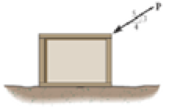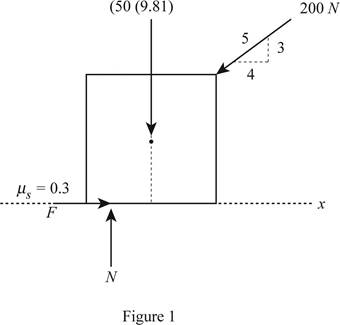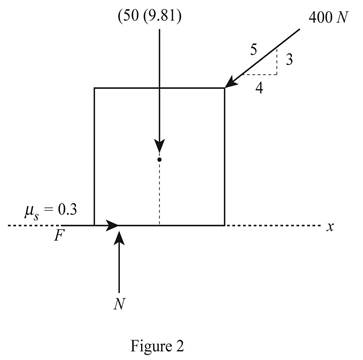
Concept explainers
F8–1. Determine the friction developed between the 50-kg crate and the ground if a) P=200 N, and b) P=400 N. The coefficients of static and kinetic friction between the crate and the ground are, μs = 0.3 and, μk = 0.2.

(a)
The frictional force (F).
Answer to Problem 1FP
(a) The frictional force (F) is
(b) The frictional force (F) is
Explanation of Solution
Given:
The mass of the crate (m) is 50 kg.
The co-efficient of static friction
The co-efficient of kinetic friction
Show the free body diagram of the crate as in Figure (1).

Using Figure (1),
Determine the normal reaction (N) using the equation of equilibrium.
Along the vertical direction:
Here, the acceleration due to gravity is g.
Determine the frictional force using the equation of equilibrium.
Along the horizontal direction:
Conclusion:
Substitute 50 kg for m,
Substitute 200 N for P in Equation (II).
Check:
Determine the maximum frictional force.
Substitute 0.3 for
The maximum frictional force (183.15 N) is greater than the frictional force (160 N); therefore the block will not slip.
Therefore, the frictional force is
(b)
The frictional force (F).
Answer to Problem 1FP
The frictional force (F) is
Explanation of Solution
Given:
The mass of the crate (m) is 50 kg.
The co-efficient of static friction
The co-efficient of kinetic friction
Show the free body diagram of the crate as in Figure (2).

Using Figure (2),
Determine the normal reaction (N) using the equation of equilibrium.
Along the vertical direction:
Determine the frictional force using the equation of equilibrium.
Along the horizontal direction:
Conclusion:
Substitute 50 kg for m,
Substitute 400 N for P in Equation (IV).
Check:
Determine the maximum frictional force.
Substitute 0.3 for
The maximum frictional force (219.15 N) is less than the frictional force (320 N); therefore the block will slip. Hence, find the frictional force using the co-efficient of kinetic friction.
Find the frictional force using the relation.
Substitute 0.2 for
Thus, the frictional force is
Want to see more full solutions like this?
Chapter 8 Solutions
PEARSON ETEXT ENGINEERING MECH & STATS
- To make an introduction to a report of a simple design of a compressed air system, which uses the criterion of speed, and not that of pressure drop, to determine the diameter of the pipes, where the capacity of the compressor and the demands of the equipment are expressed in flow.arrow_forwardIn an irrigation system, the following characteristics of the pipe network are available.• 100 meters of 4" PVC pipe, 3 gate valves• 500 meters of 3" PVC pipe, 4 gate valves• 200 meters of 2" H.G. pipe, 2 globe valves• 50 litres per second circulate in the pipes:Calculate:1. Total energy losses in meters.2. Leaks in pipes.3. Losses in accessories.4. Calculate the equivalent pipe of that system assuming only pipes without fittings.Solve the problem without artificial intelligence, solve by one of the expertsarrow_forwardLiquid water enters the boiler at 60 bar. Steam exits the boiler at 60 bar, 540°C and undergoes a throttling process to 40 bar before entering the turbine. Steam expands adiabatically through the turbine to 5 bar, 240°C, and then undergoes a throttling process to 1 bar before entering the condenser. Kinetic and potential energy effects can be ignored. Draw a Temperature-Entropy diagram and mark each of the states 2-5 on this diagram. Determine the power generated by the turbine, in kJ per kg of steam flowing. For the valves and the turbine, evaluate the rate of entropy production, each in kJ/K per kg of steam flowing.arrow_forward
- Find the componenets of reactions at pins of A, B and D please show the detailed process and instructions for learning draw out all diagrams please and thank youarrow_forwardA cast iron cylinder of 200 mm inner diameter and 12.5 mm thick is closely wound with a layer of 4 mm diameter steel wire under a tensile stress of 55 MN/m². Determine the stresses set up in the cylinder and steel wire if water under a pressure of 3 MN/m² is admitted in the cylinder. Take E= 100 GN/m², E = 200 GN/m² and Poisson's ratio = 0.25.arrow_forwardWhat is the effect of a clogged fuel injector?arrow_forward
- You are asked to design a unit to condense ammonia. The required condensation rate is 0.09kg/s. Saturated ammonia at 30 o C is passed over a vertical plate (10 cm high and 25 cm wide).The properties of ammonia at the saturation temperature of 30°C are hfg = 1144 ́10^3 J/kg andrho_v = 9.055 kg/m 3 . Use the properties of liquid ammonia at the film temperature of 20°C (Ts =10 o C):Pr = 1.463 rho_l= 610.2 kf/m^3 liquid viscosity= 1.519*10^-4 kg/ ms kinematic viscosity= 2.489*10^-7 m^2/s Cpl= 4745 J/kg C kl=0.4927 W/m C hfg*=hfg+0.68Cpl(Tsat-Given Ts) a) Instead of one plate you want to use small plates and install many of them. Calculate the requiredsurface temperature to achieve the desired condensation rate (0.09 kg/s) if you install 36vertical plates (with the same dimension as above: 10 cm high and 25 cm wide).arrow_forward11-19 designed in Problem The shaft shown in figure P11-4 was 10-19, for the data in the row(s) assigned from table PII-1, and the corresponding diameter of shaft found in Problem 10-19, design suitable bearings 5 E8 cycles at the load for at least State all assumptions. to support 1200rpm. (a) Using hydrodynamically lubricated bronze sleeve bearings with ON = 40, Lld = 0.8, and clearance ratio 0.0025. of a ← gear T gear Key figure PI-4 Given from the problem 10-19 we get d= 1.153 in from the table 11-1 we get a = 16 in b= 18in L= 20inarrow_forwardIn an irrigation system, the following characteristics of the pipe network are available.• 100 meters of 4" PVC pipe, 3 gate valves• 500 meters of 3" PVC pipe, 4 gate valves• 200 meters of 2" H.G. pipe, 2 globe valves• 50 litres per second circulate in the pipes:Calculate:1. Total energy losses in meters.2. Leaks in pipes.3. Losses in accessories.4. Calculate the equivalent pipe of that system assuming only pipes without fittings.Solve the problem without artificial intelligence, solve by one of the expertsarrow_forward
- In a series pipe, calculate the diameter 2 according to the following:• Ltotal: 325 m• L1: 52 m, D1: 3/4"• L2: 254 m, D2:?• L3: 19 m, D: 1-1/4".Indicate the nominal diameter. Solve without using artificial inteligence, solve by one of the expertsarrow_forwardWhat is the critical speed of the shaft in rad/s for one, two, and three elements?arrow_forward2. Express the following complex numbers in rectangular form. (a) z₁ = 2еjл/6 (b) Z2=-3e-jπ/4 (c) Z3 = √√√3e-j³/4 (d) z4 = − j³arrow_forward
 International Edition---engineering Mechanics: St...Mechanical EngineeringISBN:9781305501607Author:Andrew Pytel And Jaan KiusalaasPublisher:CENGAGE L
International Edition---engineering Mechanics: St...Mechanical EngineeringISBN:9781305501607Author:Andrew Pytel And Jaan KiusalaasPublisher:CENGAGE L
